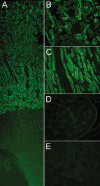Distribution and regulation of expression of serum- and glucocorticoid-induced kinase-1 in the rat kidney
- PMID: 12816971
- PMCID: PMC2343216
- DOI: 10.1113/jphysiol.2003.042903
Distribution and regulation of expression of serum- and glucocorticoid-induced kinase-1 in the rat kidney
Abstract
The serum- and glucocorticoid-induced kinase-1 (sgk1) increases the activity of a number of epithelial ion channels and transporters. The present study examines the distribution and subcellular localization of sgk1 protein in the rat kidney and the regulation of levels of expression induced by steroids. The results indicate that the kidney expresses predominantly the sgk1 isoform with a distribution restricted to the thick ascending limb of Henle, distal convoluted, connecting and cortical collecting tubules. Within cells, sgk1 strongly associates with the microsomal fraction of homogenates and it colocalizes with the Na+,K+-ATPase to the basolateral membrane. Analysis of the levels of expression of sgk1 by Western blotting and immunohistochemistry indicates constitutive high expression under basal conditions. Approximately half of the basal level is maintained by glucocorticoids whereas physiological fluctuations of aldosterone produce minor changes in sgk1 abundance in adrenal-intact animals. These results do not support the notion that physiological changes of aldosterone concentration turn the expression of sgk1 'on and off' in the mammalian kidney. Additionally, localization of sgk1 to the basolateral membrane indicates that the effects mediated by sgk1 do not require a direct interaction with the ion channels and transporters whose activity is modulated, since most of these proteins are located in the apical membrane of renal epithelial cells.
Figures









References
-
- Alliston TN, Maiyar AC, Buse P, Firestone GL, Richards JS. Follicle stimulating hormone-regulated expression of serum/glucocorticoid-inducible kinase in rat ovarian granulosa cells: a functional role for the Sp1 family in promoter activity. Mol Endocrinol. 1997;11:1934–1949. - PubMed
-
- Alper SL, Stuart-Tilley AK, Biemesderfer D, Shmukler BE, Brown D. Immunolocalization of AE2 anion exchanger in rat kidney. Am J Physiol. 1997;274:F601–614. - PubMed
-
- Alvarez de la Rosa D, Canessa CM. Role of SGK in hormonal regulation of the epithelial sodium channel in A6 cells. Am J Physiol Cell Physiol. 2003;284:C404–414. - PubMed
-
- Alvarez de la Rosa D, Zhang P, Naray-Fejes-Toth A, Canessa CM. The serum and glucocorticoid kinase sgk increases the abundance of epithelial sodium channels in the plasma membrane of Xenopus oocytes. J Biol Chem. 1999;274:37834–37839. - PubMed
-
- Bhargava A, Fullerton MJ, Myles K, Purdy TM, Funder JW, Pearce D, Cole TJ. The serum- and glucocorticoid-induced kinase is a physiological mediator of aldosterone action. Endocrinology. 2001;142:1587–1594. - PubMed
Publication types
MeSH terms
Substances
Grants and funding
LinkOut - more resources
Full Text Sources

